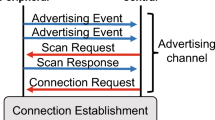Abstract
This paper aims at improving the performance of spectrum mobility in cognitive radio local area networks under a congested environment. Due to the atmospheric turbulence and random effects of fading and multipath shading, the nature of the propagation channel could be affected. For this, the link with the smallest SNR can be considered. The main purpose of the present paper is to enhance the SNR link and the end-to-end throughput, and to reduce the expected transmission time from the primary base station towards the secondary user under the used spectrum, while considering that the secondary user is in motion. To meet these objectives, three algorithms have been suggested, namely the Kalman Filter, the Alpha–Beta Filter and the Simple Recursive Estimator. The Kalman Filter and the Alpha–Beta Filter have been particularly used to estimate the path of a secondary user node, while the Simple Recursive Estimator has been employed to get better primary signal sensing in a congested environment. In the end, the simulation results obtained allowed demonstrating the effectiveness of the proposed algorithms. Note that the average expected total transmission time could be reduced to 4.1827 s, while the mean end-to-end throughput reached the value 3.67 kbps.















Similar content being viewed by others
References
Akyildz, I. F., Lo, B. F., & Balakrishnan, R. (2011). Cooperative spectrum sensing in cognitive radio networks: A survey. Physical Communication, 4(1), 40–62. https://doi.org/10.1016/j.phycom.2010.12.003.
Mitola, J. (2000). Cognitive radio: An integrated agent architecture for software defined radio. Dissertation, Royal Institute of Technology.
Abdel-Rahman, M. J., Krunz, M., & Erwin, R. (2015). Exploiting cognitive radios for reliable satellite communications. International Journal of Satellite Communications and Networking, 33, 197–216. https://doi.org/10.1002/sat.1083.
Ghasemi, A., & Sousa, E. (2005). Collaborative spectrum sensing for opportunistic access in fading environments. In Proceedings of IEEE DySPAN: Baltimore, MD, USA (pp. 131–136). https://doi.org/10.1109/dyspan.2005.1542627.
Chatzinotas, S., Evans, B., Guidotti, A., Icolari, V., Lagunas, E., Maleki, S., et al. (2017). Cognitive approaches to enhance spectrum availability for satellite systems. International Journal of Satellite Communications and Networking, 35(5), 407–442. https://doi.org/10.1002/sat.1197.
Adardour, H. E., Meliani, M., & Hachemi, M. H. (2017). Improved local spectrum sensing in cluttered environment using a simple recursive estimator. Computers & Electrical Engineering, 61, 208–222. https://doi.org/10.1016/j.compeleceng.2016.11.037.
Adardour, H. E., Meliani, M., & Hachemi, M. H. (2015). Estimation of the spectrum sensing for the cognitive radios: Test analysing using Kalman filter. Wireless Personal Communications, 84(2), 1535–1549. https://doi.org/10.1007/s11277-015-2701-y.
Ivan, C., Sangman, M., Ilyong, C., & Jinyi, L. (2012). Spectrum mobility in cognitive radio networks. IEEE Communications Magazine, 50(6), 114–121. https://doi.org/10.1109/MCOM.2012.6211495.
Ihsan, A. A., & William, H. T. (2007). Dynamic spectrum allocation in cognitive radio using hidden Markov models: Poisson distributed case. SoutheastCon, Proceedings. IEEE: Richmond, VA, USA, March 2007 (pp. 196–201). https://doi.org/10.1109/secon.2007.342884.
Shuta, K., Takeo, F., & Osamu, T. (2014). Dynamic spectrum sharing for OFDMA-based multi-hop cognitive radio networks with priority. Wireless Personal Communications, 74(3), 1081–1097. https://doi.org/10.1007/s11277-013-1345-z.
Yuh, S. C., Ching, H. C., Ilsun, Y., & Han, C. C. (2011). A cross-layer protocol of spectrum mobility and handover in cognitive LTE networks. Simulation Modelling Practice and Theory, 19(8), 1723–1744. https://doi.org/10.1016/j.simpat.2010.09.007.
Yuh, S. C., & Jia, S. H. (2013). A relay-assisted protocol for spectrum mobility and handover in cognitive LTE networks. IEEE Systems Journal, 7(1), 77–91. https://doi.org/10.1109/JSYST.2012.2205089.
Feng, G., & Shengjun, X. (2013). A comparative study of mobility models in the performance evaluation of MCL. In IEEE wireless and optical communication conference: Chongqing, China (pp. 288–292). https://doi.org/10.1109/wocc.2013.6676324.
Kalata, P. R. (1981). The tracking index: A generalized parameter for α–β and α–β–γ target trackers. IEEE Transactions on Aerospace and Electronic Systems, 20(2), 174–182. https://doi.org/10.1109/taes.1984.310438.
Tenne, D., & Singh, T. (2002). Characterizing performance of α–β–γ filters. IEEE Transactions on Aerospace and Electronic Systems, 38(3), 1072–1087. https://doi.org/10.1109/taes.2002.1039425.
Adardour, H. E., & Kameche, S. (2017). Predicting the primary signal sensing for cognitive radio users using an alpha-beta filter. In IEEE proceeding of the 5th international conference on electrical engineering: Boumerdes, Algeria. https://doi.org/10.1109/icee-b.2017.8191969.
Andrea, G. (2005). Wireless communications. Cambridge: Cambridge University Press.
Maurice, B. (1998). Traitement numérique du signal (6th ed.). Paris: Dunod.
Author information
Authors and Affiliations
Corresponding author
Additional information
Publisher's Note
Springer Nature remains neutral with regard to jurisdictional claims in published maps and institutional affiliations.
Rights and permissions
About this article
Cite this article
Adardour, H.E., Kameche, S. Enhancing the Performance of Spectrum Mobility in Cognitive Radio Local Area Networks Using KF-ABF-SRE Estimators. Wireless Pers Commun 104, 1321–1341 (2019). https://doi.org/10.1007/s11277-018-6085-7
Published:
Issue Date:
DOI: https://doi.org/10.1007/s11277-018-6085-7




